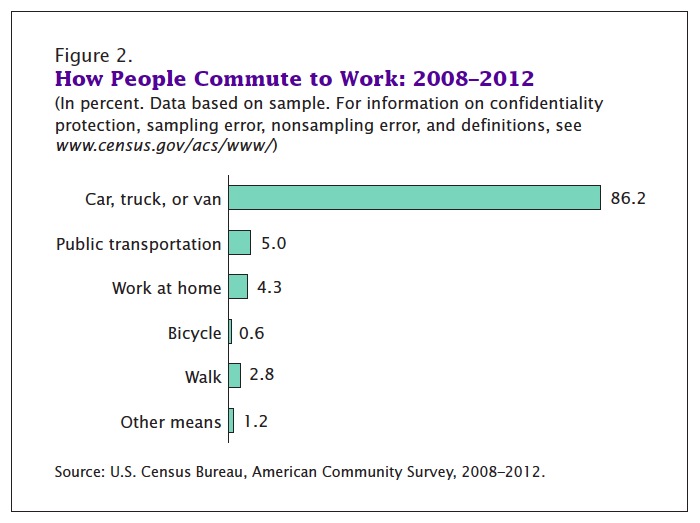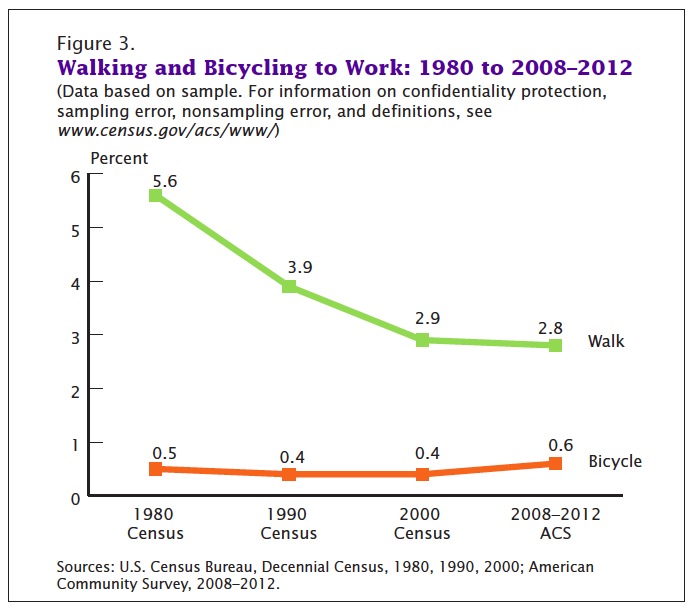UNITED STATES CENSUS BUREAU
Bicycling and walking make up a relatively small portion of commuting activity in the United States, but these nonmotorized travel modes play important roles within many of the nation’s local transportation systems. Infrastructure that supports bicycling and walking expands transportation options and may complement other forms of transportation by supplementing segments of trips. Several state and local agencies have taken steps to promote pedestrian and bicycle travel. Strategies to accommodate nonmotorized travel vary across communities, but may include sidewalk modifications, pedestrian-oriented commercial centers, or bicycle lanes to name a few. In recent years, the number of cities with bicycle sharing programs has increased considerably.1 These efforts reflect ongoing changes in infrastructure and travel options across the nation’s dynamic transportation systems. Such changes influence decisions people make about their trip to work. The American Community Survey (ACS) is an important tool for tracking how the nation’s travel patterns change across time and places.
Among other questions on work-related travel, the ACS asks respondents how they get to work. Respondents may choose from among several transportation modes, including bicycle or walked (Figure 1). The ACS commuting questions have served as the basis for several U.S. Census Bureau reports, but this is the first report to focus on bicycling or walking.2 This report provides a national overview of commuting by bicycle and walking in the United States. It highlights differences in rates of nonmotorized travel for selected social and economic population characteristics and across geographic areas.3 The report uses the 5-year 2008–2012 ACS data to take advantage of its large sample size relative to the 1-year data, thus reducing margins of error of estimates for small subpopulations.
Highlights
- The number of U.S. workers who traveled to work by bicycle increased from about 488,000 in 2000 to about 786,000 in 2008–2012, a larger percentage increase than that of any other commuting mode.
- The combined rate of bicycle commuting for the 50 largest U.S. cities increased from 0.6 percent in 2000 to 1.0 percent in 2008–2012.
- The Northeast showed the highest rate of walking to work at 4.7 percent of workers, while the West had the highest rate of biking to work at 1.1 percent. The South had the lowest rate of biking and walking to work.
- Among large cities, Portland, OR, has the highest bicycle commuting rate at 6.1 percent.
- Workers living in principal cities walked to work at a rate of 4.3 percent, compared with 2.4 percent for workers in suburbs.
- Several “college towns” showed high rates of walking to work, including Ithaca, NY, and Athens, OH, where about 42.0 percent and 37.0 percent of workers walked to work, respectively.
- Younger workers,those aged 16 to 24, had the highest rate of walking to work at 6.8 percent.
- At 0.8 percent, the rate of bicycle commuting for men was more than double that of women at 0.3 percent.
- At 0.9 percent, the most educated workers, those with a graduate or professional degree, had the highest rate of bicycle commuting, followed by the least educated workers, those who did not graduate from high school at 0.7 percent.
- Workers who walked to work had an average commute time of 11.5 minutes, considerably shorter than that of bicycle commuters at 19.3 minutes, and all other workers who did not work at home at about 25.9 minutes.
The ACS is a survey conducted annually by the Census Bureau to gather information about changes in the socioeconomic, housing, and demographic characteristics of communities across the United States and Puerto Rico.5 It provides one of the most robust sources of information on commuting by bicycle and walking. ACS questions related to travel focus solely on commuting and do not ask about leisure travel or other nonwork trips. Commutes may involve multiple transportation modes, but ACS respondents are restricted to indicating the single mode used for the longest distance.
Information on nonmotorized travel is limited relative to that of travel by automobile or transit. This presents challenges for transportation planners and researchers interested in gaining a better understanding of bicycle and pedestrian travel behavior and demand.6 Analysis of trends in commuting by bicycle and walking is complicated by the relatively low prevalence of these modes, creating issues related to small sample size. Because bicycling and walking often serve as secondary travel modes that supplement modes such as transit or driving, some commutes that involve bicycling and walking are not reflected as such in the ACS because another mode is used for a longer distance.

Download full version (PDF): Modes Less Traveled—Bicycling and Walking to Work in the United States
About the U.S. Census Bureau
www.census.gov
The Census Bureau’s mission is to serve as the leading source of quality data about the nation’s people and economy. We honor privacy, protect confidentiality, share our expertise globally, and conduct our work openly. We are guided on this mission by scientific objectivity, our strong and capable workforce, our devotion to research-based innovation, and our abiding commitment to our customers.
Tags: American Community Survey Reports, Bicycling, Cycling, Pedestrian, U.S. Census, United States Census Bureau, Walking







 RSS Feed
RSS Feed